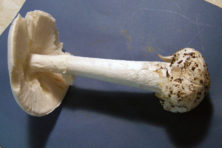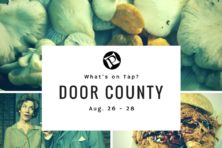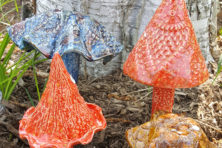Mushroom Season
- Share
- Tweet
- Pin
- Share
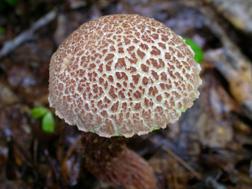
The most recent new species found in Door County, at Newport Park, Russell’s Bolete showing the top of the cap. Photo by Roy Lukes.
September and October spell wild mushroom time, cooler crisper air, fewer pesky insects and long exploratory hikes. Growing up in a Bohemian family meant eating mushrooms. My dad was very skilled at finding and picking his favorite, the Honey Mushroom, also called Vaclavky (VOTS-luv-kee) in the Czech Language, and my mom canned many jars of them in most years and used them to ambrosial perfection in her cooking. Her recipe for Vaclavky soup remains our favorite to this day.
If people were to ask us, “When is the best time to go searching for wild mushrooms?” – our answer would be “today!” Buy a good mushroom field guide, such as our second-favorite, Mushrooms of Northeast North America by George Barron. It includes detailed information about 609 species and contains 875 excellent colored photographs. The author states: “It is more fun photographing fungi than eating them and less risky.” The organization of this field guide is outstanding, as are its many self-learning suggestions.
Charlotte has become very skilled in identifying wild mushrooms, after 38 years of field work, collecting, reading and researching, and studying the mushroom species with scientific methods including a good hand lens and also a microscope with an oil-immersion lens. Important data for you to gather at the site of the living mushroom include: getting a good colored photo or digital image, noting the habitat and host (what it is growing on), measuring the size of the mushroom, its cap and stem, determining if it is gilled or non-gilled, and detecting if it has an odor or fragrance.
Collect a fresh specimen and obtain a good spore print on white paper, which will clearly indicate the color of the spores. Carefully cut the cap from the stem and place it face down on the paper. Cover the cap using an empty cottage cheese container. It is best to leave the cap covered for several hours – overnight is ideal. Now the spore color can be determined. A powerful microscope with a measuring scale included will allow you to determine the size of the spores and their shape.
Generally the rainfall has been adequate for good mushrooming this fall. Bear in mind that mushrooms can be collected in all state parks but not in Wisconsin State Natural Areas. Never hike and gather mushrooms on private property without permission from the owner. In case you plan to collect some species for spore examination later, don’t mix the specimens in one container. Place the species in separate containers such as small waxed sandwich bags.

Nick Anderson looking at several Artist’s Polypores, sometimes called Artist’s Conk, on a dead Hemlock tree. Photo by Roy Lukes.
To date, Charlotte has recorded 545 mushroom species in Door County. Her longest list is for Whitefish Dunes State Park, because it’s fairly close to our home and she did ten years of study there. Other good lists are from the Ridges Sanctuary, the Toft Point State Natural Area, and Newport State Park. We are very anxious to do more mushroom study and photographing on Washington Island and Rock Island State Park.
One of the most exciting mushroom finds, a first for Door County, was the beautiful Russell’s Bolete, Boletelus russelli, located recently at Newport State Park. A group of highly skilled artists working together couldn’t have come up with a more beautiful combination of shapes, textures and colors.
Another beauty, although not a new one, we found recently at the Door County Land Trust’s Canal Property is the Birch Lenzites, also called the Gilled Bracket Fungus, Lenzites betulina (len-ZY-tees bet-you-LIE-na). Both the upper and lower surfaces are strikingly beautiful. Betula is the genus for Birch, so you can expect to find this woody fungus growing on dead Paper Birch limbs lying on the ground.
One reason we especially enjoy learning more about the bracket fungi is that quite a few species are woody and readily withstand dry weather, making their discovery much more likely and predictable. Favorite specimens include the Artist’s Conk, Red-banded Polypore, Turkey Tail, Tinder Polypore or Horse’s Hoof Fungus, and one of our very favorite species, the Hemlock Polypore, Ganoderma tsugae (gan-o-DER-ma SOO-gee, pronounced with a hard ‘g’). These grow on rotting Hemlock logs in shaded woods. Yes, “Tsugae” is the genus of Hemlock.
Using a good quality hand lens can add immense pleasure to your mushroom study. The tiny, dainty and very attractive and colorful Waxy Caps come to life through a hand lens. A seasonal favorite is the Orange-gilled Mycena whose dark-orange edges of its tiny gills show clearly through a lens. One of the smallest and awe-inspiring species to inspect with a lens is the Eyelash Cup, Scutellinia scutellata.
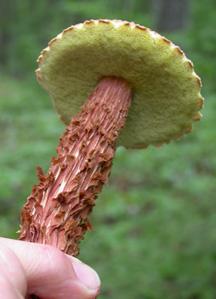
The most interesting stalk of Russell’s Bolete. Photo by Roy Lukes.
The word “mushroom” likely stems from the French word mousseron, referring to moss. Many are found growing not necessarily in moss but rather in mossy places. This is one of our favorite aspects of mushroom study – where they grow.
Even though we relish wild species of mushrooms, we are quite satisfied to dine on the “store-bought” varieties. Bear in mind that there are old mushroom hunters, and there are bold mushroom hunters, but never old bold mushroom hunters! See you in the woods!

